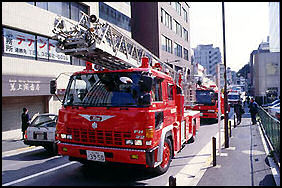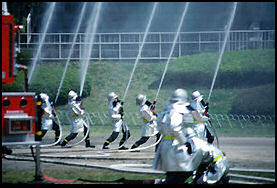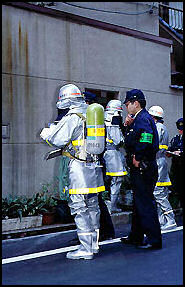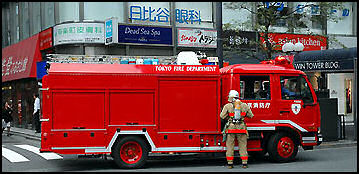FIRES AND MAN-MADE DISASTERS IN JAPAN

Japanese hook and ladder In November 1974, thirty-three crew members died in a huge explosion and fire on a an tanker carrying liquified petroleum gas and naphtha when the tanker collided with a cargo ship in Tokyo Bay. The tanker was towed outside the bay and struck with torpedoes fired from a submarine and destroyer and still continued to burn for more 20 days.
In October 2007, a 9-year-old boy went into a coma after leaning over the handrail of an escalator and getting his neck caught between a handrail and safety barriers in Hiratsuka, Kanagawa Prefecture.
In September 2007, three people were killed and four were injured when a 800-ton shipbuilding crane collapsed at a shipyard in Kobe. A 50-meter arm on he crane fell off while it was being repaired. Nine workers were working on the crane at the time of the accident. The three men that died fell from distances of between 12 and 36 meters.
In December 2007, four people were killed at an explosion ay a Mitsubishi Chemical Corp. plant in Kamisu, Ibaraki. The explosion occurred at cracking furnace — used to refine naphtha and propylene — at ethylene plant.
Each summer scores of people die in water-related accidents. Many drown in rivers or ooff beaches. Others die in boating accidents. It is not unusual for a dozen people to die nationwide on a single day during a hot summer weekend.
Firemen wear samurai-style headgear and shout in unison during training drills.
Natural Disasters, See Earthquakes, Volcanos, Typhoons, Floods, Nature. Also Check Nuclear Accidents, Energy; Train Disasters and Airline Crashes, Transportation
Good Websites and Sources: Wikipedia article on Fires in Japan Wikipedia ; Fire in the U.S. and Japan pdf file nfpa.org/assets/files/pdf ; Fire Statistics stat.go.jp/english ; Good Photos of Firemen at Japan-Photo Archive japan-photo.de ;
Fires in Japan

fireman training The worst fire since World War II occurred at the Senninchi Department Store in Osaka in May 1972. It killed 118 and injured 49. A fire in November 1973 at Taiyo Department Store in Kumamoto killed 104 and injured 124.
In November 1980, a fire at the Kawaji Prince Hotel in Kawaji spa resort in Tochigi Prefecture killed 45 people and injured 22. A fire in February 1982 at the Hotel New Japan in Tokyo killed 33 and injured 25. A fire in February 1986 at the Atagawa spa resort in Shizuola prefecture killed 24.
In April 2003, nine people died in an explosion at a fireworks factory in Kagoshima. Some 50 houses within a 500-meter radius of the factory were damaged by shock waves. A kind of firework known as Niagra Fall was being made at the time of the disaster. The kind of gunpowder used are very explosive. Witnesses said their was an initial explosion followed by secondary explosions caused when gunpowder in storage areas ignited.
See Bridgestone, Economics
In September 2003, a fire in naphtha storage tank triggered by an earthquake burned for 44 hours before it was extinguished in Tomakoma, Hokkaido. The fire was spectacular, producing fireballs, flames and black smoke. Nearly all the fuel in the huge tank was burned up before the fire went out. Firefighters didn’t have the proper equipment to put it out.
In January 2006, three teenagers died in a fire at a karaoke box in Takarazuka near Osaka. The fire was caused by a cooking oil fire in the karaoke’s kitchen caused by an unattended oil-filled wok left burning on a stove. The dead teenagers were trapped on the second floor where the windows had been boarded up and could not be used to escape. The karaoke was not registered with the government and did not have adequate fire-prevention measures.
The owner of the karaoke box in Takarazuka was found guiltily of professional negligence resulting in death and failing to maintain fire safety standards and was sentenced to prison. The woman who started the fire in the kitchen was also arrested for professional negligence. A probe done after the fire found that 70 percent of Japan’s karaoke boxes violated fire laws. Among the violations were failure to use nonflammable curtains and carpets and failing to install fire escape ladders or slides.
In December 2009, four workers were killed when a cylindrical tank containing toxic gas exploded at a chemical plant in Yodogawa Ward, Osaka. The four victims, who were working near the top of the tank, were blown through the roof. The blast occurred after one worker cut a hole in the tank to remove sludge that had collected inside it Access to plant was restricted for hours because of concerns over the chemicals.
In November 2009, four people were killed and 12 were injured in a fire at an izakaya restaurant in Sugunami ward in Tokyo. A survivor said the fire broke out as a cook was preparing skewered food in front of him and the set fire to a piece of decorative cloth hanging from the ceiling. He said, “I saw a pillar of fire that spread” through the restaurant “in a split second. Then the restaurant went pitch-black due to the smoke.” A few days earlier, a fire at a mah-jongg parlor in Himatsu, Shizuoka Prefecture killed four people.
In March 2010, seven elderly people with dementia died in a nursing home fire in Sapporo, the nursing was not outfit with sprinklers or adequate alarms and most of those that died were unable to get out. The fire started from a stove in the first floor of the facility. The home had been reprimanded for not having an adequate fire escape plan. The home had not broken any laws for not having sprinklers or alarms. Because of the high cost for these items it had been given a grace period until 2012 to obtain these items.
Fire in Shinjuku

fireman training In September 2001, forty-four people died in a fire that broke out in a building in the Shinjuku entertainment district in Tokyo after an explosion near a gas meter at a mah-jongg parlor on the third floor. Most of the dead were in the crowded mah-jongg parlor and the hostess bar above it. The explosion occurred at around 1:00am and quickly engulfed the building in flames. There were few escapes routes and people leapt from the windows. Most of the dead died from carbon monoxide poisoning.
One survivor told the Yomiuri Shimbun, "There were so many people who couldn't escape. The heat and smoke were terrible. I could not find a place to put my foot because were so many victims and pieces of the ceiling." Many of the businesses in the building had not met fire safety regulations for fire escapes, did not have required fire safety equipment, and had not submitted fire prevention reports.
Fire in the Video Theater in Osaka
In October 2008, a fire in a video theater — made up of 32 small two-square meter rooms, for private viewing of DVDs and videos, on one floor in a seven-story multi-tenant building — in the Namba entertainment district of Osaka killed 16 people and injured 10.
The video theater, called Shishashitsu Cats theater, was open 24 hours and rented out rooms for ¥1,500 from 11:00pm to 10:00am. It was often used by people who missed the last train home or didn’t have much money and crashed out there in a pinch or as an alternative to sleeping on the street. The cubicles had enough floor space for a person to lie down.
The fire destroyed 40 square meters of the 220-square-meter facility and damaged the walls of the building before it was put 90 minutes after it started. There were 26 customers — all of them men — and three employees in building when the fire broke out. The employees manged to escape but 15 customers — believed to have been sleeping when the fire broke out — didn’t make it out, with most of them dying from carbon monoxide poisoning caused by smoke inhalation.
The fire was set around 3:00am by an 46-year-old unemployed man, Kazuhiro Ogawa, who ignited some papers in the cubicle he was in. Burdened by family, health and financial problems, he told police, “I just didn’t want to live any longer, so I set fire to the room” but fled for safety because he couldn’t stand the heat and smoke. According to friends of Ogawa he lost his job and was divorced in 2001 and lost a lot of money gambling and owed million of yen to loan sharks.
The rooms in the video were located off a narrow hallway. There was only one way out: via a door by the reception area, The windows were walled over and several of the exits were blocked. There was no sprinkler system or adequate smoke ventilation system. Even so an inspection a little over year earlier found nothing amiss. The manager switched off the fire alarm shortly after the fire broke out, thinking it was a false alarm. The evacuation lights were off making it difficult to find a way out.
One survivor, a 37-year-old man, told the Daily Yomiuri, he as watching television when he smelled burning wood and heard a theater employee yell, “Oh my God! What’s happening.” He said he opened the door of his room and smoke started to pour in. “Thank God I was awake at the time. If I hadn’t notice it right away, I’d probably have died.” A 50-year-old man that crawled on his stomach because of the heavy smoke said no one came out after him. An employee said, “All I could do was escape. My eyes hurt, and I couldn’t see.”
The Osaka pachinko arsonist got the death penalty
Fire at Hiroshima Hotel in May 2012 Kills Seven, Injures Three
In May 2012, Kyodo reported: “Seven people were killed and three others injured after a fire broke out at the Hotel Prince in Fukuyama, Hiroshima Prefecture, police said. Three men and four women were killed in the 7 a.m. blaze, with a hotel employee among the three injured, the police said. The death toll rose to seven after a victim initially in serious condition was later pronounced dead. [Source: Kyodo. May 14, 2012]
“About 20 guests were staying at the four-story hotel when the fire broke out, they said, adding it was extinguished shortly after 10 a.m. "I smelled something bad, so I looked out a window," said a housewife, 57, who lives nearby. "Then I saw black smoke spewing from the hotel." Witnesses also saw a couple make their escape by jumping out of the window of a second-floor room and landing without serious injuries.
“The Yomiuri Shimbun reported: “The deadly fire that ravaged a hotel in Fukuyama, Hiroshima Prefecture, may have been caused by a short circuit or another electrical defect, according to police and other sources. It has been learned that the hotel had not been inspected by fire department officials since 2003. Serious damage was discovered on a wall near the switchboard at the Hotel Prince's front desk, and Hiroshima prefectural police suspect the fire started at this point and spread to the second and third floors through the ceiling. Local firefighters agree with this assumption. [Source: Yomiuri Shimbun, May 16, 2012]
“The front desk is located roughly at the center of the hotel's two buildings--a two-story wooden structure and a partly four-story reinforced concrete building. The police and officials of the Fukuyama district firefighting association found serious damage on the east wall where the switchboard was located near the front desk.A 75-year-old woman, who was the only employee present in the hotel when the fire broke out, was quoted by police as saying that although she tried to put the fire out, it was too late. The woman, who suffered head and hand burns, gave her statement to police in a hospital.
The Minami Fire Department, which exercises jurisdiction over Hotel Prince, has not conducted an on-site inspection of the hotel for more than 8-1/2 years. Fire department chief Hiromichi Yokoyama repeatedly expressed remorse that the hotel had not been inspected since 2003 and bowed deeply to reporters. According to the bureau's regulations, on-site inspections are supposed to be conducted every two years at hotels and other buildings where large numbers of people congregate. The Yomiuri Shimbun has learned that the woman who runs the hotel said she had no money to improve smoke-detection equipment when she was told to do so by an official of the Fukuyama city office in September 2011. The official was taken by the woman to the third floor of the building and the wooden building could be seen from there. The official said it was dark because the outside light was not working and the emergency electric lighting system was inadequate.
Refinery Tunnel Floods Kill Five
In February 2012, the Yomiuri Shimbun reported: “Five workers went missing at the Mizushima Refinery of JX Nippon Oil & Gas Exploration Corp. in Kurashiki, Okayama Prefecture, after a tunnel they were digging flooded with seawater. According to the Kurashiki fire department, the flooding occurred at about 12:35 p.m. when six workers were digging the tunnel for an underwater pipeline at the refinery. One of the six workers managed to get out the tunnel to safety, but the whereabouts of the remaining five were unknown, the fire department said.According to the worker who escaped, seawater poured into the tunnel after a collapse occurred. [Source: Yomiuri Shimbun, February 8, 2012]
Overpass Disaster in Kobe

In July, 2001, eleven people were crushed to death and 129 people were injured on crowded overpass in Kobe after a fireworks display that drew 130,000 people. The 6-meter-wide, 100-meter overpasses crossed a busy highway and was on the primary route between the fireworks display site and the nearest subway station.
The disaster occurred as the crowds began heading back to the subway station after the fireworks show finished as people were still arriving by train and directed to the overpass. The overpass became packed with people as people from both direction kept arriving. The pressure of all the pushing people was so great it caused the metal guardrail to bend and collapse. Most of the dead were children.
The deaths were blamed on inadequate crowd control measures and poor communications. One person who was there told the Yomiuri Shimbun, "I started shaking when I saw this many people were packed onto the overpass. Crowds of people were heading towards the overpass from the station, and north and west of the station, but no one tried to stop them, I thought that was strange." Local government officials were blamed for the disaster by not making better plans and doing more to prevent things from getting out of hand when the overpass became crowded, A police official and four others were found guilty or professional negligence.
Gangplank Disaster in Oita

In January 2009, two people died and 23 were injured when a gangplank to a cargo ship at a shipyard in Oita collapsed, sending workers falling to the pier and into the sea. About 40 people were believed to be to be on the 29-meter-long gangplank when it collapsed. Nearly 100 people were involved un the rescue and medical aid efforts. The accidents was blamed on gangplank-supporting brackets whose load-bearing capacity had not been tested.
Four Die After Tunnel Blast in Japan
In May 2012, Jiji Press reported: “Four workers were confirmed dead after being found in a tunnel where an explosion occurred in Minami-Uonuma, Niigata Prefecture,. At about 12:15 a.m., rescuers from the city's firefighting department found the four workers about 1,300 meters from the entrance of the tunnel, which is still under construction. The four were taken to medical institutions, including the prefectural Muikamachi Hospital, but they were all confirmed dead. [Source: Jiji Press-Daily Yomiuri, May 28, 2012]
“On the same day, the police conducted searches in three locations, including branch offices in Toyama and Niigata of Sato Kogyo Co., a Chuo Ward, Tokyo-based construction firm in charge of construction work. The police plan to investigate the company on suspicion of professional negligence resulting in injuries to determine whether its safety measures were adequate. The city's firefighting headquarters said the rescuers found the four workers earlier but had to delay retrieving their bodies because of the high concentration of gas in the tunnel.
Fire at Hiroshima Hotel in May 2012 Kills Seven, Injures Three
In May 2012, Kyodo reported: “Seven people were killed and three others injured after a fire broke out at the Hotel Prince in Fukuyama, Hiroshima Prefecture, police said. Three men and four women were killed in the 7 a.m. blaze, with a hotel employee among the three injured, the police said. The death toll rose to seven after a victim initially in serious condition was later pronounced dead. [Source: Kyodo. May 14, 2012]
“About 20 guests were staying at the four-story hotel when the fire broke out, they said, adding it was extinguished shortly after 10 a.m. "I smelled something bad, so I looked out a window," said a housewife, 57, who lives nearby. "Then I saw black smoke spewing from the hotel." Witnesses also saw a couple make their escape by jumping out of the window of a second-floor room and landing without serious injuries.
“The Yomiuri Shimbun reported: “The deadly fire that ravaged a hotel in Fukuyama, Hiroshima Prefecture, may have been caused by a short circuit or another electrical defect, according to police and other sources. It has been learned that the hotel had not been inspected by fire department officials since 2003. Serious damage was discovered on a wall near the switchboard at the Hotel Prince's front desk, and Hiroshima prefectural police suspect the fire started at this point and spread to the second and third floors through the ceiling. Local firefighters agree with this assumption. [Source: Yomiuri Shimbun, May 16, 2012]
“The front desk is located roughly at the center of the hotel's two buildings--a two-story wooden structure and a partly four-story reinforced concrete building. The police and officials of the Fukuyama district firefighting association found serious damage on the east wall where the switchboard was located near the front desk.A 75-year-old woman, who was the only employee present in the hotel when the fire broke out, was quoted by police as saying that although she tried to put the fire out, it was too late. The woman, who suffered head and hand burns, gave her statement to police in a hospital.
The Minami Fire Department, which exercises jurisdiction over Hotel Prince, has not conducted an on-site inspection of the hotel for more than 8-1/2 years. Fire department chief Hiromichi Yokoyama repeatedly expressed remorse that the hotel had not been inspected since 2003 and bowed deeply to reporters. According to the bureau's regulations, on-site inspections are supposed to be conducted every two years at hotels and other buildings where large numbers of people congregate. The Yomiuri Shimbun has learned that the woman who runs the hotel said she had no money to improve smoke-detection equipment when she was told to do so by an official of the Fukuyama city office in September 2011. The official was taken by the woman to the third floor of the building and the wooden building could be seen from there. The official said it was dark because the outside light was not working and the emergency electric lighting system was inadequate.
Refinery Tunnel Floods Kill Five
In February 2012, the Yomiuri Shimbun reported: “Five workers went missing at the Mizushima Refinery of JX Nippon Oil & Gas Exploration Corp. in Kurashiki, Okayama Prefecture, after a tunnel they were digging flooded with seawater. According to the Kurashiki fire department, the flooding occurred at about 12:35 p.m. when six workers were digging the tunnel for an underwater pipeline at the refinery. One of the six workers managed to get out the tunnel to safety, but the whereabouts of the remaining five were unknown, the fire department said.According to the worker who escaped, seawater poured into the tunnel after a collapse occurred. [Source: Yomiuri Shimbun, February 8, 2012]
Image Sources: Japan Photo japan-photo.de ;
Text Sources: New York Times, Washington Post, Los Angeles Times, Daily Yomiuri, Times of London, Japan National Tourist Organization (JNTO), National Geographic, The New Yorker, Time, Newsweek, Reuters, AP, Lonely Planet Guides, Compton’s Encyclopedia and various books and other publications.
Last updated August 2012
